From waste to watts: How General Mills turns yogurt into power.
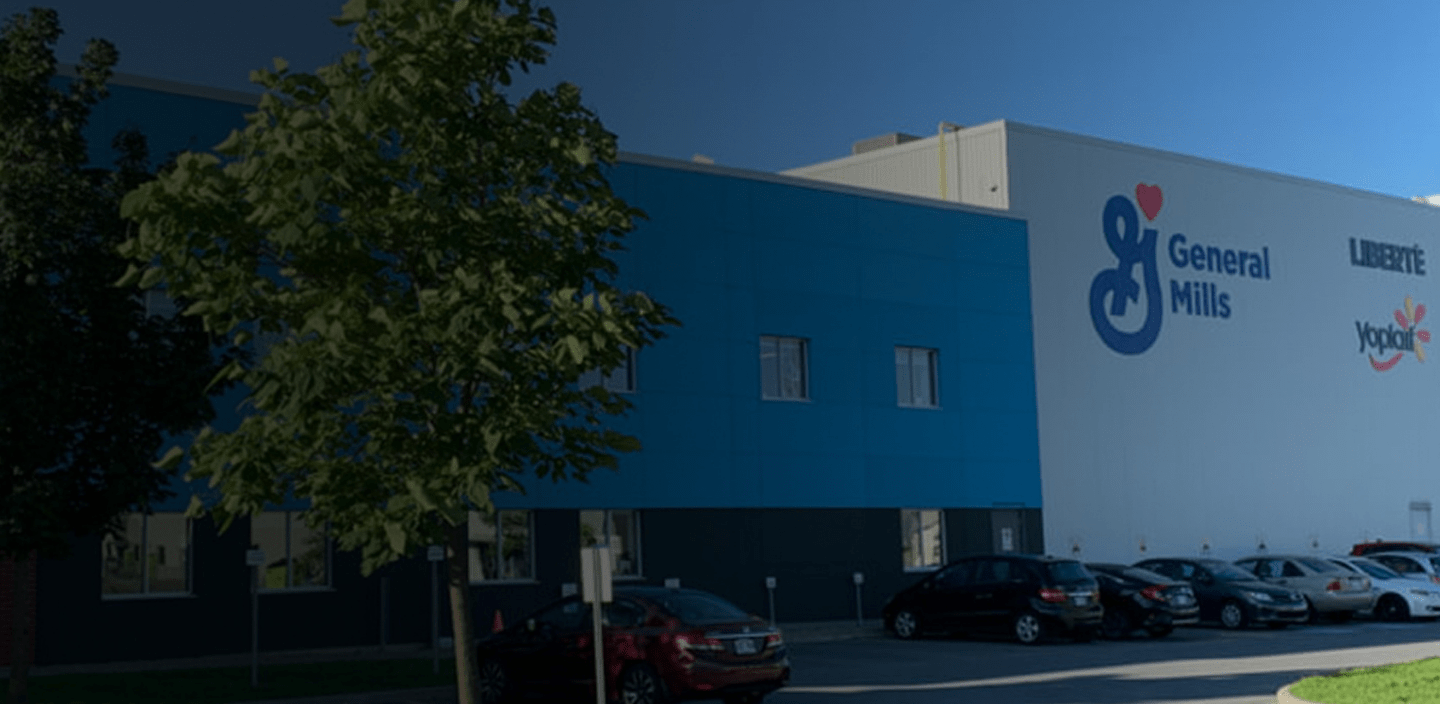
It might sound like science fiction, but in Murfreesboro, Tennessee, yogurt waste is helping power the grid. At General Mills’ massive facility—home to iconic brands like Pillsbury and Yoplait—a clever use of dairy byproducts is reducing emissions, improving resilience and offering a model that other manufacturers could follow.
Here’s how it works — and why it matters.
What’s in yogurt waste? And why it’s powerful.
Greek yogurt production generates a significant amount of byproduct known as acid whey — a nutrient-rich liquid that’s expensive to dispose of and challenging to manage. But it also happens to be full of organic material that breaks down well in a process called anaerobic digestion.
Anaerobic digesters are machines that break down food and plant waste using tiny microbes (like bacteria) that don’t need oxygen. As the microbes consume the waste, they produce a methane-rich gas, also known as biogas, which can be used to generate electricity.
At General Mills’ Murfreesboro plant, that biogas is used to power a 1.6-megawatt generator, supplying energy right back to the facility and offsetting fossil fuel use. Even better? The leftover material (digestate) can sometimes be repurposed as fertilizer.
Sources: epa.gov; generalmills.com
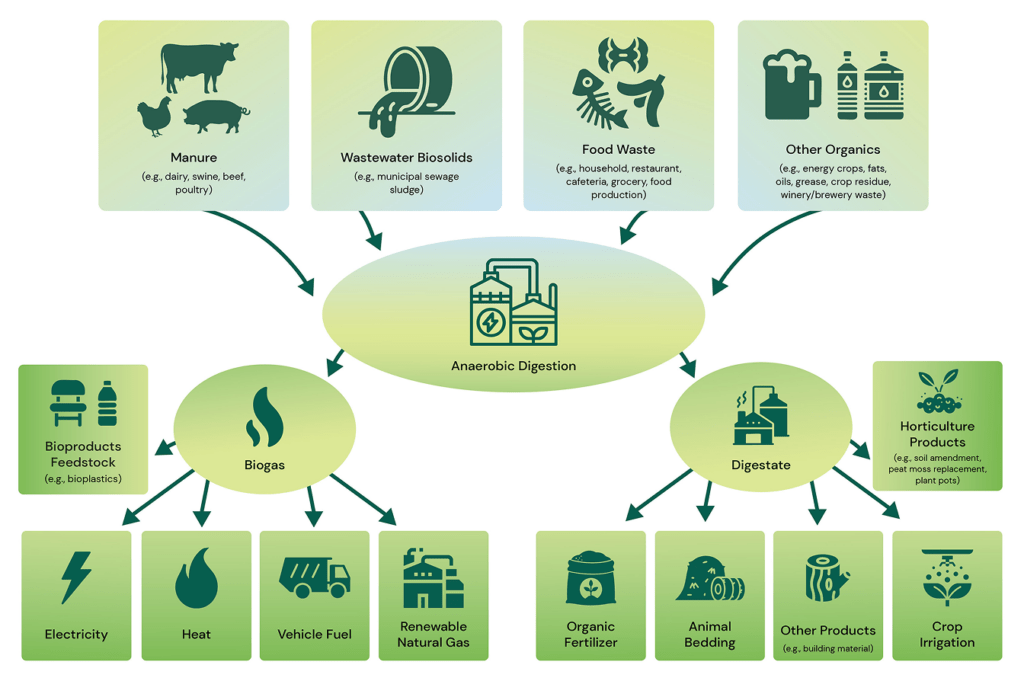
Why is the Middle Tennessee plant location unique?
The General Mills site is unique not just for its size — it’s one of the largest Yoplait producers in the country — but for its on-site wastewater treatment plant. Plus, with a demand load exceeding 15 megawatts — one of only four General Mills plants globally to reach that threshold — the facility’s energy performance has a significant impact on both operational efficiency and sustainability goals. When the facility expanded to accommodate Greek yogurt production, it invested in an anaerobic digester to handle the acid whey and other organic waste.
With support from federal clean energy tax credits and strong technical assistance from Middle Tennessee Electric (MTE), the plant was able to safely integrate the generator into the grid. That partnership was essential to making the system viable — not just technically, but economically.
Daren Kaiser, Global Energy Strategy Leader for General Mills, says, “We got 40% of that cost covered by a federal rebate, but the real win was Middle Tennessee Electric’s willingness to partner with us. MTE was with us every step of the way. They probably worked harder than our contractors to make sure it came together. That kind of partnership makes innovation possible.”
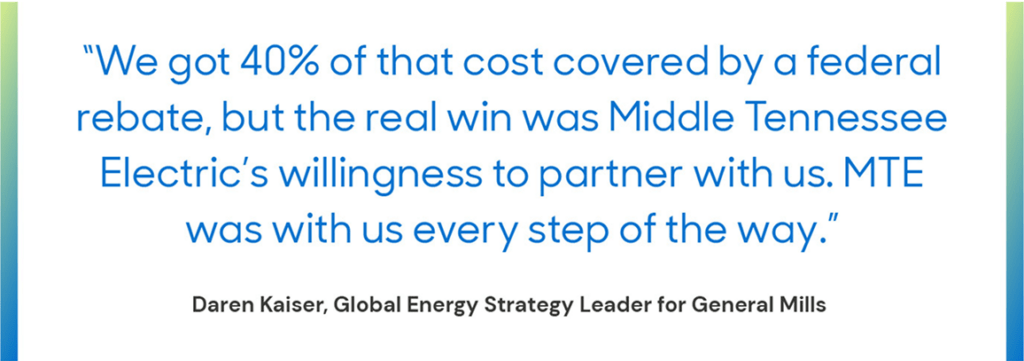
What’s the impact?
The anaerobic digester is a low-emission, high-reward system that helps General Mills:
- Reduce a facility’s Scope 1 emissions (by burning natural gas).
- Save on waste disposal costs.
- Generate renewable electricity.
- Increase energy resilience for a plant that operates 24/7 and can’t afford outages.
- Keep valuable nutrients out of landfills or waterways.
The anaerobic digester at General Mills provides a powerful win-win for business and the environment. Beyond reducing Scope 1 emissions and cutting waste disposal costs, it generates clean, reliable power — perfect for a plant that can’t tolerate downtime. Plus, the digestate, a semi-solid material left over from the anaerobic digestion process, can be used as fertilizer, keeping nutrients in the loop rather than allowing them to leach into landfills or waterways.
Source: cen.acs.org
Can other industries do this, too?
Yes! Anaerobic digestion is also being used by:
- Food and beverage manufacturers (especially dairy, meat and produce)
- Breweries (spent grains and yeast waste)
- Agriculture (manure and crop waste)
- Municipalities (food scraps, sewage sludge, biosolids)
The keys to success? A consistent waste stream with sufficient volume to justify the system, and strong local utility partnerships to help manage grid integration and incentives.
For companies under pressure to meet sustainability goals without sacrificing uptime or margins, anaerobic digestion offers a compelling win-win. What starts as a byproduct of creamy Yoplait ends up fueling the plant that makes it. In a time of increasing energy demands, turning waste into energy might be one of the smartest, most scalable strategies available.
Sources: epa.gov
Ready to take the next step?
Connect with your local power company or with one of our TVA Energy Experts to explore energy-efficiency options tailored for your business or facility.
How to talk to your landlord about energy upgrades for leased spaces.
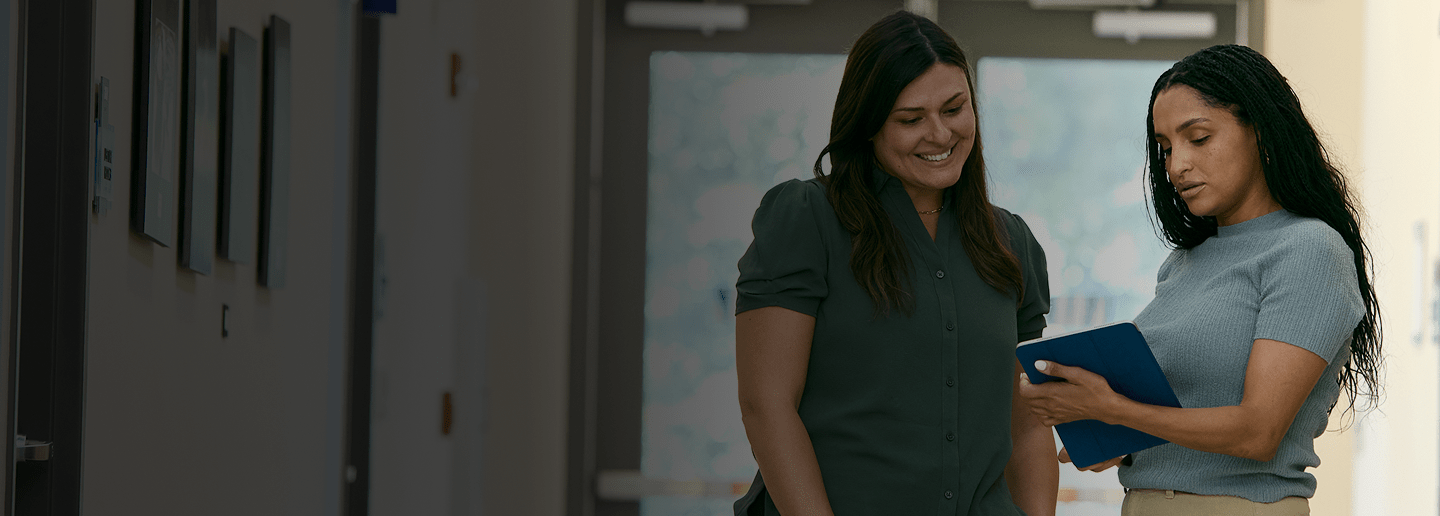
Renting your business space doesn’t mean you’re powerless when it comes to saving energy. In fact, tenants often have more influence than they realize — especially when the conversation focuses on shared benefits, such as cost savings, comfort and long-term value. Whether you’re looking to lower monthly bills, improve working conditions or enhance reliability, energy upgrades can be a win-win for both you and your landlord. Here’s how to approach the conversation with confidence.
Why energy upgrades for leased spaces matter for tenants.
If you’re dealing with rising energy bills, inconsistent temperatures or outdated lighting, you’re not alone. Many tenants in leased commercial spaces face these issues—and feel stuck because they don’t own the building. But energy upgrades can dramatically improve your day-to-day experience. Efficient lighting, smart thermostats, HVAC tune-ups and insulation improvements can all make your space more comfortable and productive, while lowering operating costs at the same time.
And the benefits go beyond the utility bill. Strategic upgrades can reduce maintenance issues, improve system reliability and even enhance employee or customer satisfaction. The key is making sure your landlord sees the value, too. Here are some steps you can take to start the conversation.
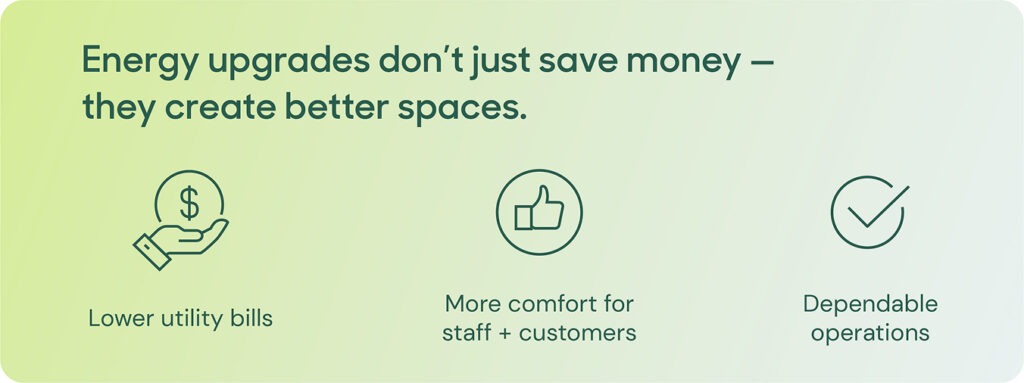
1. Understand potential roadblocks.
Tenant-landlord dynamics may impact decisions about building improvements. You may not have full authority to make changes to systems like lighting or HVAC, and your landlord may not feel motivated to invest in upgrades that primarily lower your bills — a common issue known as a split-incentive problem. You reap the savings, and they pay the upfront cost.
Short-term leases can be another barrier. Landlords might worry they won’t see a return on investment if tenants relocate before the payback period ends. But these objections aren’t deal-breakers. They’re just part of the conversation. Being prepared can help you address them head-on.
2. Identify your opportunities.
Before starting the conversation, take the time to identify specific upgrades or improvements that could make a significant impact in your space. Start with areas that offer high energy savings and fast paybacks, like:
- LED lighting uses up to 75% less energy compared to incandescent lighting.
- Smart thermostats to automate temperature control based on occupancy.
- HVAC tune-ups to improve indoor air quality, efficiency and extend system life.
- Weatherization and insulation to help stabilize indoor temperatures.
Even better: gather quick data on potential cost savings using tools like TVA EnergyRight’s incentive calculator. You can also note any performance issues like hot or cold spots, flickering lights, or equipment noise that support your case for improvements.

Sources: Energy.gov, EnergyRight.com; nrel.gov
3. Turn talk into savings.
The best time to talk about energy upgrades is before there’s a problem—not after the HVAC system fails on a 90-degree day. Bring up the topic during a lease renewal, a property walkthrough or even a casual check-in. Come prepared with:
- A short list of potential upgrades.
- Examples from similar properties or business case studies.
- Information on available TVA EnergyRight® incentives.
Sharing success stories or information on incentives from TVA EnergyRight can make your pitch more concrete and less abstract.

Sources: ApartmentTherapy.com; EnergyRight.com; Score.org
4. Frame the conversation as a win-win.
Once you’ve identified your priorities, focus on how these upgrades can benefit both you and your landlord. The goal is to reframe the request as a shared investment in the property’s long-term value.
For you as a tenant, the value is clear: lower energy bills, increased comfort and more reliable operations. For your landlord, the upgrades can translate into higher building value, lower vacancy rates and a more marketable property. In today’s competitive rental market, energy-efficient buildings are becoming increasingly attractive to prospective tenants—especially those seeking modern, sustainable spaces.
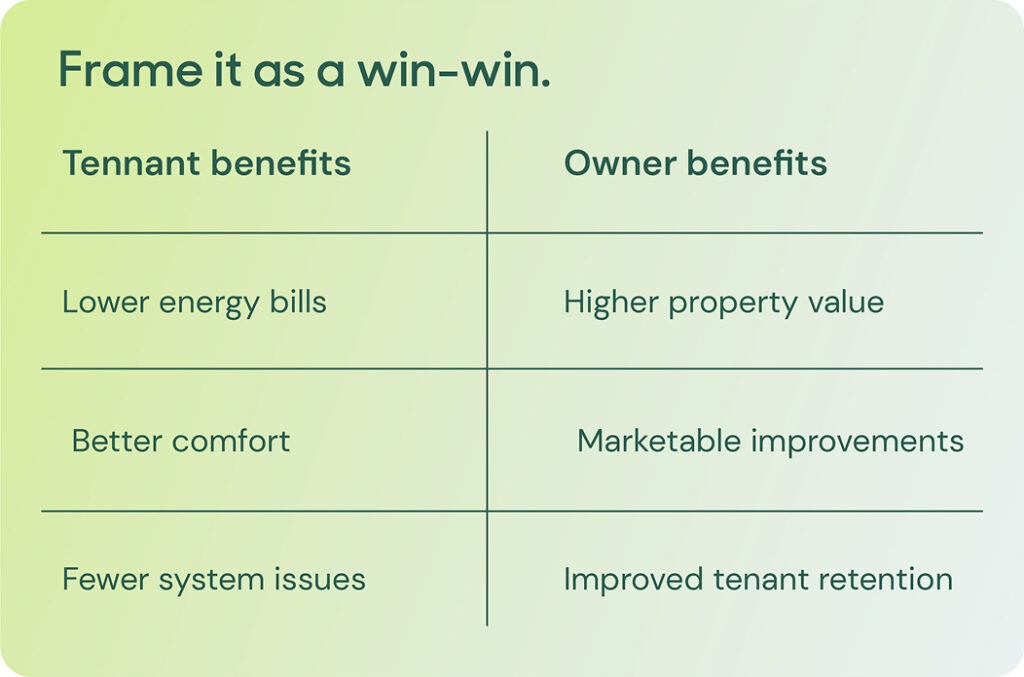
Source: EnergyStar.gov
5. Offer to partner in the process.
You don’t have to make the request and hope for the best — you can offer to be part of the solution. If you’re proposing larger upgrades, suggest starting small with a pilot project like retrofitting just one area with LED lighting. You can also propose a cost-sharing model or help by researching contractors, gathering quotes or completing incentive paperwork. This kind of proactive partnership can go a long way in showing your landlord that you’re serious and solution-oriented.
Another way to strengthen the landlord-tenant partnership around upgrades is through an energy-aligned lease. Instead of leaving energy use and costs to chance, these agreements build energy efficiency language directly into the lease itself. For example, clauses can allow landlords to recover a portion of capital expenses for upgrades through operating costs while ensuring tenants share in the savings.
According to the Institute for Market Transformation, energy-aligned leases can reduce utility bills by up to $0.51 per square foot and cut office building energy use by as much as 22%. In practice, this turns the split-incentive problem into a shared-investment model — landlords benefit from higher property value and improved net operating income. At the same time, tenants gain lower bills, better comfort, and more reliable systems.
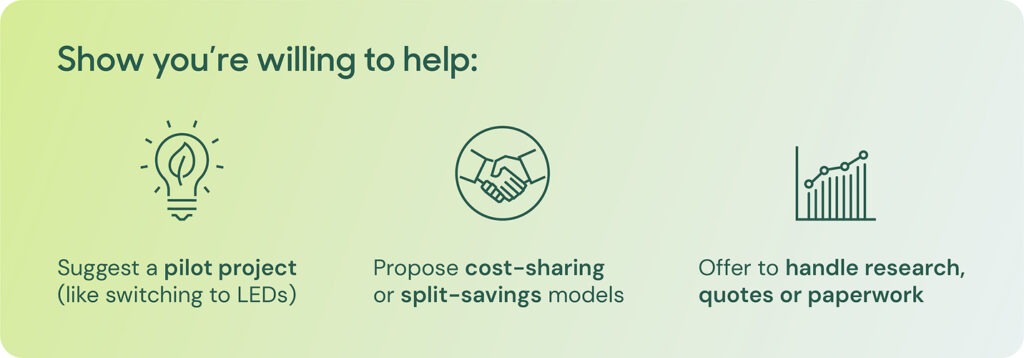
Take the next step.
If your landlord is open to the idea, recommend setting up a walkthrough with your local power company or another energy expert. TVA EnergyRight can provide tools, resources and support to help identify energy upgrades for leased spaces and the available incentives.
Remember, you don’t have to navigate this alone. Even a single conversation can lead to improvements that benefit everyone who uses the space.
A win-win worth talking about.
Energy upgrades don’t just save money — they create better places to do business. And while you may not own the building, you can help shape its future. So, go ahead. Start the conversation with your landlord, focus on the mutual benefits, and come prepared with information and ideas.
Need help? Connect with a TVA Energy Expert to explore your options and get expert support.
The Truth About the ROI of Energy Efficiency for Small Business Owners
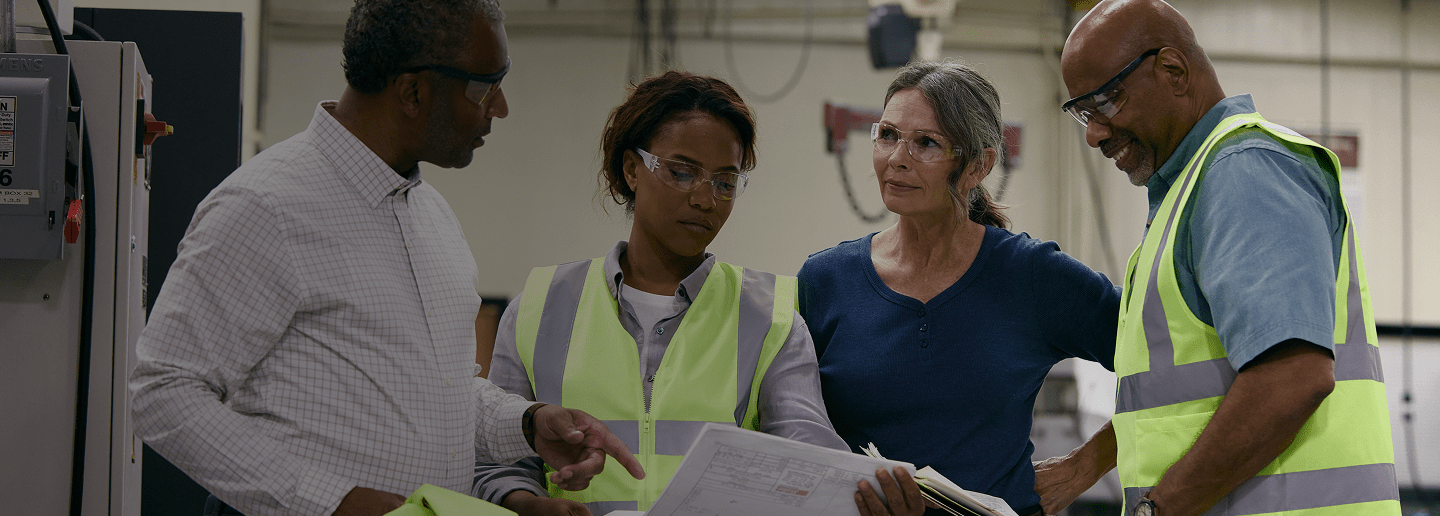
Running a small business means watching every dollar. Rent, payroll, inventory and marketing — it all adds up fast. But there’s one line item that’s often overlooked: energy costs. Utility bills can eat into margins, and unlike other expenses, they don’t go away on their own. The good news? Energy efficiency upgrades offer one of the most reliable returns on investment (ROI) available to small business owners.
Why the ROI of energy efficiency matters for small businesses.
Energy is often a top-three expense for small businesses, behind only labor and rent. That means efficiency isn’t just a sustainable choice — it’s a smart financial strategy. Beyond savings, efficiency upgrades enhance comfort, improve the customer experience and even boost employee productivity.
The case for efficiency.
The ROI of energy efficiency is measurable. According to ENERGY STAR, small businesses can cut utility costs by up to 30% with upgrades that quickly pay for themselves.
- Lower monthly bills: Upgrading equipment to more efficient models reduces energy bills. Just swapping outdated lighting for LEDs alone can reduce electricity use by up to 75%.
- Incentives and other energy solutions: Make your equipment upgrades more affordable with incentives from your local power company and TVA EnergyRight®, which can help reduce project costs and the payback period.
- Long-term value: Once installed, upgrades like HVAC and Refrigeration continue saving money year after year.

Sources: energy.gov, energystar.gov, EnergyRight.com
Small investment = big benefits.
The value of efficiency goes beyond numbers on a utility bill. A well-lit, inviting space makes a difference for everyone who walks through your doors.
Stronger customer experience: Bright, well-lit spaces encourage shoppers to stay longer — and spend more.
Better working conditions: Improved HVAC and lighting create a comfortable environment for businesses and other organizations, like schools.
Improved employee satisfaction: Studies show comfortable workplaces and better lighting boost productivity and reduce turnover.

Sources: epa.gov; hrfuture.net; pecnw.com
Real-world ROI: Ironhorn Enterprises
Energy efficiency isn’t just about trimming bills—it can help seal business deals, too. Take Ironhorn Enterprises, a commercial real estate firm specializing in industrial and warehouse properties.
When a new tenant was interested in leasing an Oak Ridge, Tennessee, warehouse, the outdated 1,000-watt metal halide lighting threatened to derail the deal. Powering the space would have been too costly for the tenant to justify.
The solution: Ironhorn partnered with the Oak Ridge Electric Department and TVA EnergyRight® to upgrade the facility with 110 energy-efficient 300-watt LED high-bay fixtures.
The results:
- 317,638 kWh annual energy savings
- $30,914 in annual energy cost savings
- $28,205 incentive from TVA EnergyRight
- Simple payback: <5 months
Beyond the impressive numbers, the upgrade helped Ironhorn secure the tenant, modernize its property and enhance long-term value.
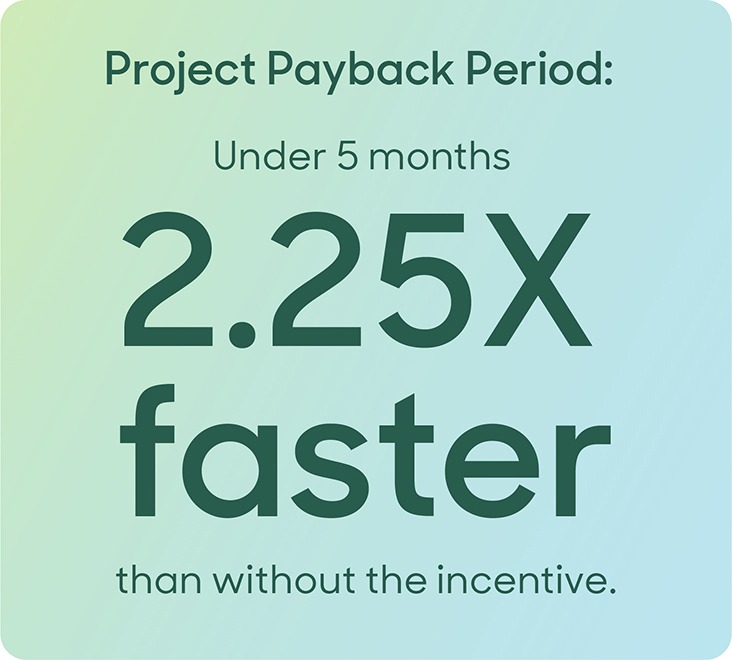
Beyond cost savings: building resilience and brand value.
Today’s customers expect businesses to operate sustainably. Using the ROI of energy efficiency metric is a way to show that you care about your community while strengthening your bottom line. It also makes your business more resilient—less vulnerable to rising energy prices or unexpected system breakdowns. Positioning your business as efficient and sustainable can become a competitive edge that attracts both customers and talent.
How to get started.
Getting started doesn’t have to be complicated.
- Save up to $375 in annual energy costs with a free Smart Energy Starter Kit from TVA Energy Right and your local power company.
- Explore TVA’s incentives and other programs to get upgrades with short payback periods.
- Work with a TVA Energy Expert to identify the best opportunities for your space.
For small business owners, energy efficiency is more than a buzzword — it’s a proven investment. Lower bills, improved comfort, happier employees, and a stronger brand all add up to measurable ROI and long-term success.
Take the first step today. Explore TVA incentives, request your Smart Energy Starter Kit and start saving.

Frequently Asked Questions
Q: What is the ROI of energy efficiency for small businesses?
The ROI varies by project, but many small businesses see payback in just a few years — or even months. For example, lighting retrofits with LED fixtures can cut electricity costs by up to 75% and often pay for themselves in under two years.
Q: What are the best energy efficiency upgrades for fast payback?
High-impact, low-cost projects, like LED lighting updates, HVAC upgrades and smart thermostats, often deliver the quickest payback. These upgrades lower monthly utility bills and improve comfort for employees and customers.
Q: Can energy efficiency improve employee productivity and customer experience?
Yes. Better lighting, consistent indoor temperatures and improved air quality create a more welcoming space. Employees tend to be more comfortable and productive, while customers enjoy spending more time in your business.
Q: How can small businesses in the region get started with energy efficiency?
TVA EnergyRight offers a complimentary Smart Energy Starter Kit to help small and mid-size businesses take the first steps to cut energy costs. If you are ready to replace equipment like LED lighting, HVAC or Refrigeration, our incentives make the investment more affordable, and a TVA Energy Expert can guide you through options that deliver the most impact for your business.
5 smart strategies to improve commercial energy efficiency.

Proven strategies for building performance, budget control and resilience in commercial environments.
Commercial energy efficiency is often framed as a daunting, high-stakes challenge. Rest assured, your energy goals are attainable. The key is to start with what you can control, lean into collaboration and let quick wins fuel your long-term strategy.
In a recent panel discussion hosted by TVA EnergyRight, energy leaders offered an objective and actionable perspective on commercial energy efficiency. Featuring voices from General Mills, Metro Nashville, Middle Tennessee Electric (MTE), and Nashville Electric Service (NES), the discussion offered practical steps organizations of all sizes in both the private and public sectors can take. Here are five standout strategies — rooted in both experience and impact.
1. Prioritize utility and government collaboration.
Work with your local power company and city team, not around them.
When working in sectors such as large industrial facilities, municipalities, hospitals or universities, efficiency goals are often developed in isolation — only to run into roadblocks related to permitting, infrastructure or communication. But when utilities and city agencies are brought in early, those barriers can become opportunities.
Public-private partnerships can accelerate impact, and transparent conversations can help clarify shared goals and smooth the path forward. For example, public-sector entities like Metro Nashville are aligning energy planning efforts across more than a dozen departments by coordinating data and infrastructure planning — proving the value of early relationship-building for shared success.
“We’re often working across a very diverse set of departments, and we’re trying to create a centralized way of thinking about energy use and performance,” explains Kendra Abkowitz, Senior Director of Sustainability and Resilience, Office of Mayor Freddie O’Connell, Metro Nashville.

Utility-customer collaboration is one of the strongest predictors of success in commercial energy efficiency programs, particularly when supported by effective data sharing and technical guidance. According to Fulcrum, partnerships that unite the strengths of different sectors around shared energy goals tend to deliver better outcomes. That’s why electric utilities often team up with local governments, technology providers and community organizations to expand energy capacity and embed smarter energy management practices across operations.
Sources: fulcrumapp.com; nashville.gov
2. Focus on community partnerships.
Broaden your network to broaden your impact.
Think beyond facility systems and consider where your community is already laying the groundwork for success. Partnering with local energy providers or city agencies can unlock funding, enhance resilience and help large energy users — like industrial facilities, municipalities, hospitals and commercial campuses — better serve their operations and communities. Tapping into these partnerships can unlock access to tax credits, grants and TVA programs. More importantly, it’s an opportunity to build trust and deliver a broader impact.
Public sector partnership in action: Powering Metro Nashville’s efficiency goals.
One standout example of partnership in action is the 160 megawatt (MW) solar project developed through TVA’s Flexibility program. This unique initiative allows participating local power companies to generate up to 5% of their energy load through locally sourced, cleaner energy.
In this case, Nashville Electric Service (NES) teamed up with Metro Nashville and Silicon Ranch to develop a utility-scale solar array that directly supports Metro’s ambitious sustainability goals — providing clean, renewable energy to power key municipal facilities, reduce carbon emissions and stabilize long-term energy costs.
This collaboration didn’t just result in new solar infrastructure. It demonstrated what’s possible when utilities and public sector organizations align their goals, share the planning process and leverage the financial and technical support available through TVA’s regional programs.
Industrial collaboration: General Mills’ waste-to-energy solution.
Private-sector businesses like General Mills are also embracing collaborative, circular solutions by working hand-in-hand with local utilities and city leaders. At their Murfreesboro, Tennessee, facility — home to the production of all Pillsbury Toaster Strudels and about half the nation’s Yoplait yogurt — they partnered with Middle Tennessee Electric (MTE) and leveraged federal green energy incentives to turn yogurt waste into usable power.
Together, they leveraged federal rebates to turn yogurt waste into energy, installing a 1.6 MW generator powered by methane from their on-site anaerobic digester. The project not only reduced emissions and operational costs but also improved site resilience, all of which was made possible by proactive support from the local power company.
Daren Kaiser, Global Energy Strategy Leader for General Mills, says, “We got 40% of that cost covered by a federal rebate, but the real win was Middle Tennessee Electric’s willingness to partner with us. MTE was with us every step of the way. They probably worked harder than our contractors to make sure it came together. That kind of partnership makes innovation possible.”
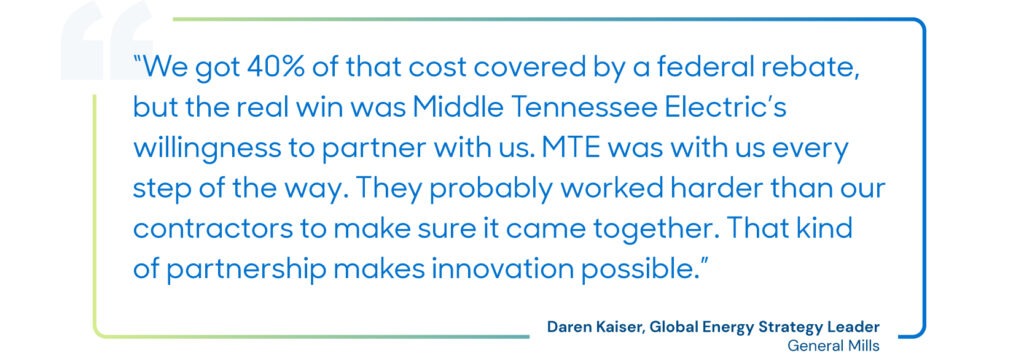
This type of solution — where waste becomes fuel and utilities help enable, rather than hinder, the process — demonstrates how circular systems can thrive through a shared vision and effective execution.
Sources: siliconranch.org; nashville.gov; cen.acs.org
3. Engage communities and employees.
Efficiency starts with people, not just systems.
Many organizations focus on systems, sensors and technology while overlooking the people who use them. However, both the City of Nashville and corporate leaders on the panel emphasized the importance of engagement in building trust and long-term buy-in.
Metro Nashville gives public tours of solar installations and dashboards to make performance visible and celebrate wins. Internally, companies like General Mills are establishing “green teams” across departments and empowering employees to participate in efficiency planning. And in large systems like hospitals, facility directors and energy teams can use similar tactics — engaging both staff and the surrounding community through energy awareness campaigns as well as training and incentives for employees to identify efficiency opportunities.
Innovative energy projects can sometimes spark internal pushback, especially when other departments are facing budget constraints. Employees may question why specific initiatives move forward while their priorities are put on hold. That’s why transparency and communication are key.
Brent Baker, EVP and Chief Operations and Innovation Officer for Nashville Electric Service, notes, “When budgets are tight, people notice where the money goes. Even if it’s a different bucket, you still have to explain why one project moves forward over another. That’s real.”

Don’t underestimate the power of storytelling. Sharing before-and-after data or involving staff in pilot projects can drive broader adoption and boost your bottom line.
When it comes to employee engagement, nearly 74% of employees report that their jobs are more fulfilling when they have the opportunity to positively impact social and environmental issues. And companies with a highly engaged workforce are 21% more profitable and 17% more productive.
Whether it’s showcasing real-time dashboards, giving public tours or celebrating internal wins, making energy progress visible helps build trust and enthusiasm. The more employees and community members understand the impact of efficiency efforts, the more likely they are to support and sustain them.
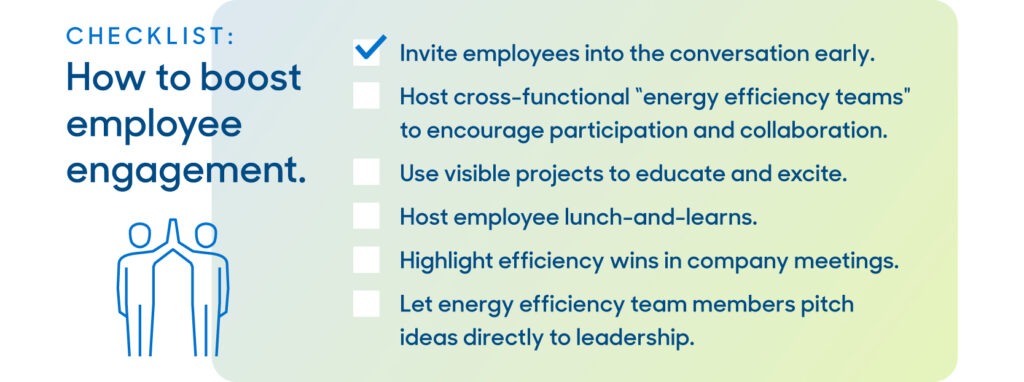
Sources: conecommunicationsco.com; gallup.com
4. Start with quick wins and build momentum.
Progress beats perfection.
Instead of getting stuck on your biggest energy challenge, start with what’s doable. Whether it’s lighting upgrades, HVAC optimization or low-barrier process improvements, small steps build trust, deliver results and recruit allies.
Kendra Abkowitz recommends identifying low-conflict opportunities — even if they don’t move the emissions needle right away.
She says, “Find your quick wins, so you can build momentum, but work where you have that runway and not too many barriers, even if it doesn’t always seem like the most impactful area. This can help gain allies for the work who can be helpful as you move into more challenging areas.”

These smaller successes are more than morale boosters — they can lay the groundwork for long-term change. According to the U.S. Department of Energy, low-cost or no-cost improvements, like LED lighting or thermostat adjustments, can reduce energy use by up to 20% in commercial buildings. That’s not just savings — it’s proof that efficiency works.
Cross-functional teams can accelerate this process. Brent Baker of NES recommends pairing skeptics with champions. “The lightbulb moments happen when cross-functional teams come together — when someone who’s not sure gets to see the benefit firsthand,” says Baker.
Source: energy.gov
5. Scale smart: invest for resilience and carbon reduction.
Pair your momentum with long-term investment.
Once you’ve captured early wins and built internal support, the next step is to take on transformational projects that deliver lasting cost savings, operational resilience and regulatory compliance — ideally with strong utility partnerships and a clear strategy for financing and implementation.
These investments may include:
- On-site solar and battery storage.
- Waste-to-energy systems such as anaerobic digesters or combined heat and power (CHP) units.
- Fleet electrification or replacing fossil-fueled equipment with electric alternatives.
Energy-intensive facilities, including manufacturing plants, universities and hospitals, can benefit from these investments, not only to reduce emissions but also to ensure energy reliability for critical systems. For example, some healthcare facilities have already implemented combined heat and power (CHP) units to enhance energy efficiency while providing a resilient backup power source for operating rooms, ICUs and labs in the event of an outage.
While the up-front costs for these technologies can be higher, aligning with utility programs and incentive structures can dramatically improve ROI. TVA’s EnergyRight incentives, for example, have helped companies across the region accelerate their transition while staying competitive. Early coordination with your local power company can also help smooth interconnections, identify potential grid limitations and ensure operational reliability.
Investing in Carbon-Free Technologies.
At General Mills, a combination of clean energy strategies has helped them reach net-zero emissions for Scope 2 electricity use, thanks to a mix of RECs and renewable power purchase agreements. To reduce Scope 1 emissions — which are typically harder to address — they’ve implemented waste-to-energy systems at several sites, including a 1.6 MW CHP unit fueled by methane from yogurt waste at their Murfreesboro plant.

Think of Scope 1 as “on-site” emissions and Scope 2 as “purchased energy” emissions.
Why it matters.
According to the International Energy Agency, clean electricity and electrification will account for more than 50% of global CO₂ reductions needed to reach net zero by 2050. Businesses that adopt low-carbon technologies now are better positioned to address regulatory shifts, meet customer expectations and ensure future energy resilience.
It’s not just about checking a sustainability box. It’s about improving reliability, controlling costs and preparing for long-term success.
Source: iea.org
The bottom line? Balance.
From morale and momentum to grid resilience to cost savings to decarbonization, the path forward isn’t one-size-fits-all, but it is a walkable one. As panelist Robert White of MTE explained, “This next generation of customers, they’re pushing, and they don’t want to hear excuses. They want to hear commitments — at the same time, we’re trying to find that balance between reliability and affordability. We want to be part of the solution.”

Meeting energy goals in both private and public commercial sectors requires balancing performance, cost and care delivery — without compromising on reliability. As TVA’s VP, Environment and Stewardship, Michael McCall explains, “There’s no free lunch. Every energy source has trade-offs. The real goal is to stay committed, work together and keep showing up.”
Ready to take the next step?
Connect with your local power company and a TVA Energy Expert to explore energy efficiency options tailored for your business or facility.
Power moves: How innovative facilities turn their utility into a strategic growth partner.
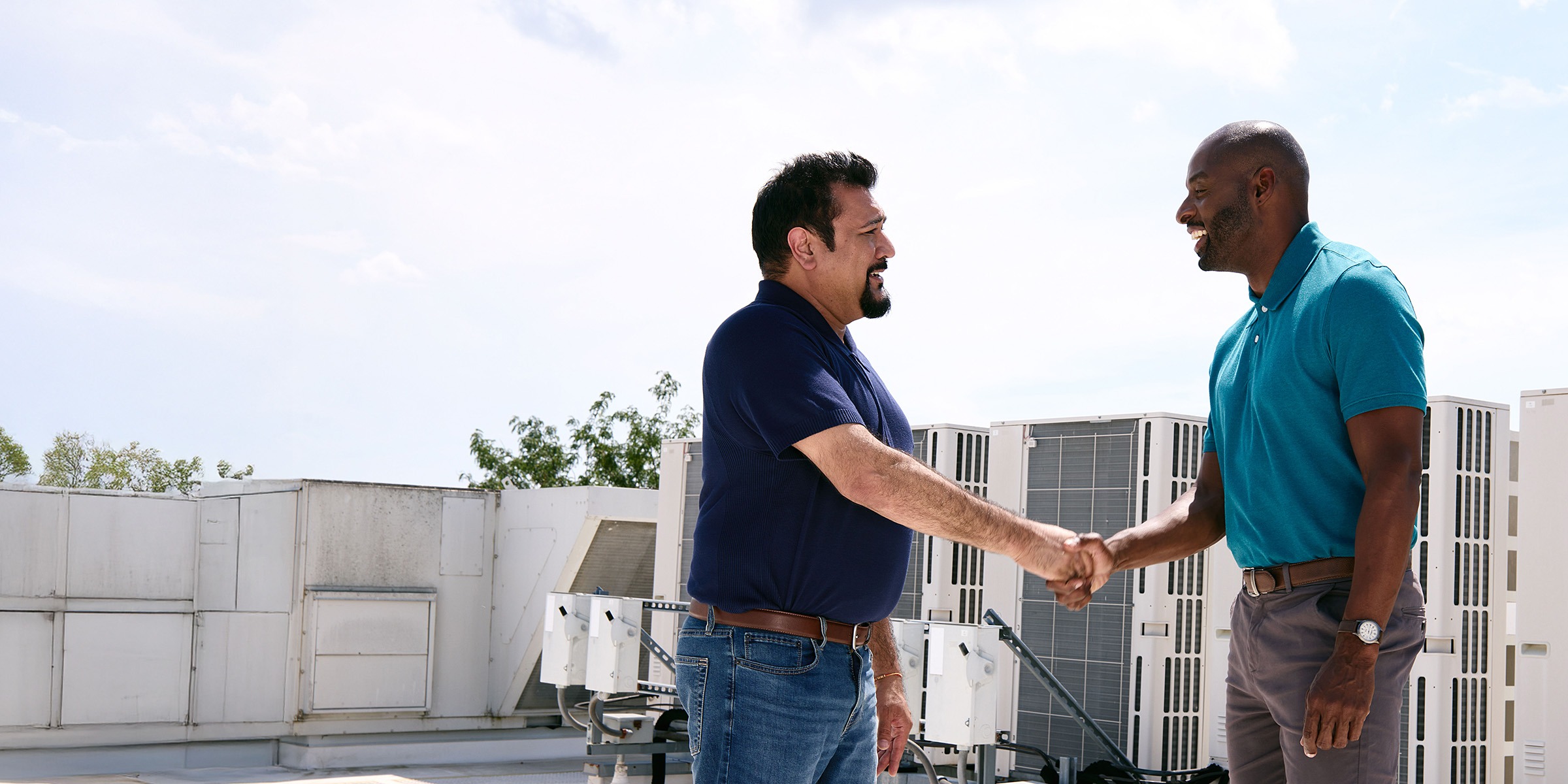
Stop thinking of your local power company as just another bill to pay. Start thinking of them as one of your competitive advantages.
Rethink what your utility can do for you.
In today’s high-stakes operational environment, energy is more than a line item — it’s a strategic lever. But most facilities treat their local power company (LPC) as a background vendor.
What if, instead, you treated them like a growth partner?
Stop overlooking your most powerful business ally. From infrastructure planning to incentive stacking, your LPC can help you cut costs, boost performance and future-proof your operations. And yes — sustainability often comes baked in.
Step 1: Bring them in early, before growth becomes a challenge.
If you’re scaling, shifting or modernizing operations, your energy needs are changing — fast.
The smartest move? Loop in your LPC before you break ground or expand your process lines.
LPCs like Middle Tennessee Electric (MTE) have helped major industrials like General Mills avoid costly redesigns and power bottlenecks by modeling future load growth, flagging infrastructure gaps and helping shape more innovative expansion plans from the start.
Robert White, VP of Community Relations & Member Services for MTE, explains, “We helped General Mills integrate a 1.6 MW anaerobic digester. We were at the table from the beginning, and that helped them avoid obstacles later.”
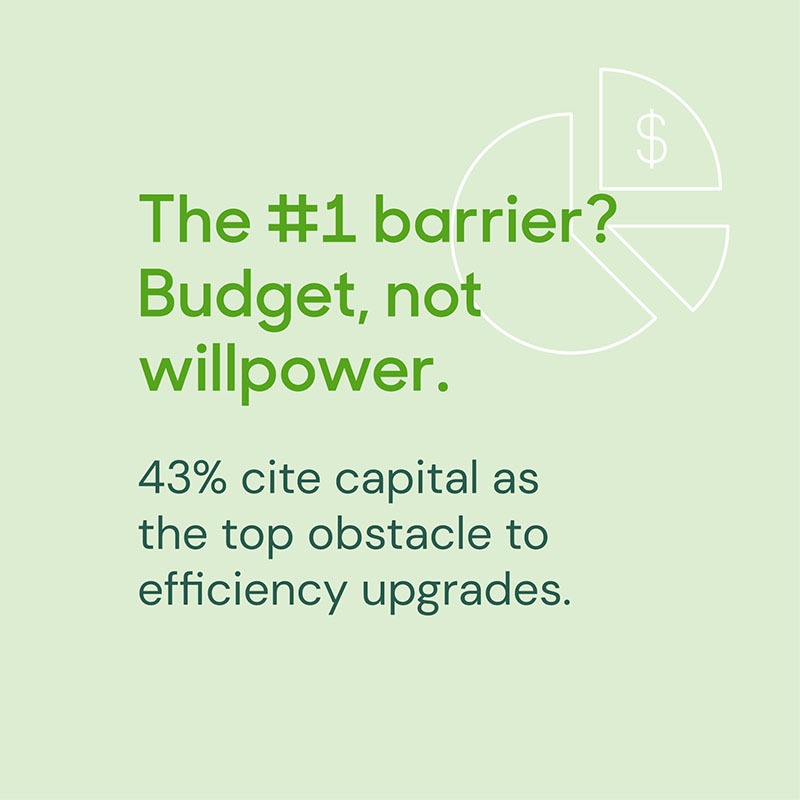
Source: deloitte.com; energy.gov
Step 2: Tap into incentives you didn’t know you had.
Efficiency upgrades can deliver fast ROI, and in the Tennessee Valley Region, LPCs in partnership with TVA EnergyRight are willing to help you pay for them. The trouble is, too many businesses leave those dollars on the table.
From lighting and HVAC to refrigeration and advanced building controls, your LPC may offer:
- Rebates that reduce capital expenditures.
- Demand response payments to reduce peak load costs.
- Shared-risk pilot programs for new technologies.
Vanderbilt University Medical Center, for example, received a $243,000 TVA EnergyRight incentive through Nashville Electric Service (NES), which is now delivering $200,000+ in annual savings.
Source: EnergyRight.com
Step 3: Use utility data to benchmark, optimize and scale.
Your LPC has visibility across sectors, regions, and use profiles. That means they know what “good” looks like — and where your facility may be falling short.
“We can bring benchmarking data to the table. That’s the power of working with an LPC that knows the territory,” says Brent Baker, EVP and Chief Operations and Innovation Officer, NES.
By sharing load data and operational goals, you can uncover:
- Inefficiencies you didn’t know existed.
- Time-of-use strategies to reduce spend.
- Long-term energy models that align with your growth targets.
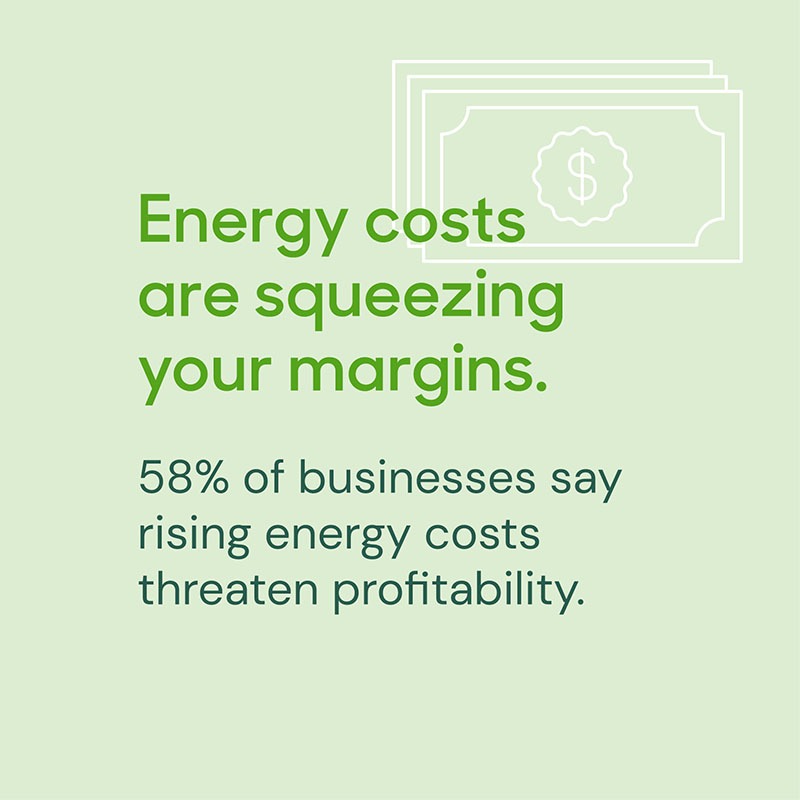
Source: energy.gov
Step 4: Reduce the risk for big ideas with a technical ally.
Innovation always carries risk — but your LPC can help you sell it to your team and manage it.
Whether you’re exploring on-site generation, EV fleet planning or battery storage, utilities can support you with:
- Interconnection guidance.
- Reliability modeling.
- Regulatory navigation and incentive layering.
General Mills has achieved net-zero Scope 2 emissions globally. With help from MTE, they integrated a 1.6 MW generator powered by yogurt waste — an anaerobic digester that cut emissions and costs while increasing energy independence.
General Mills achieved net-zero Scope 2 emissions globally.
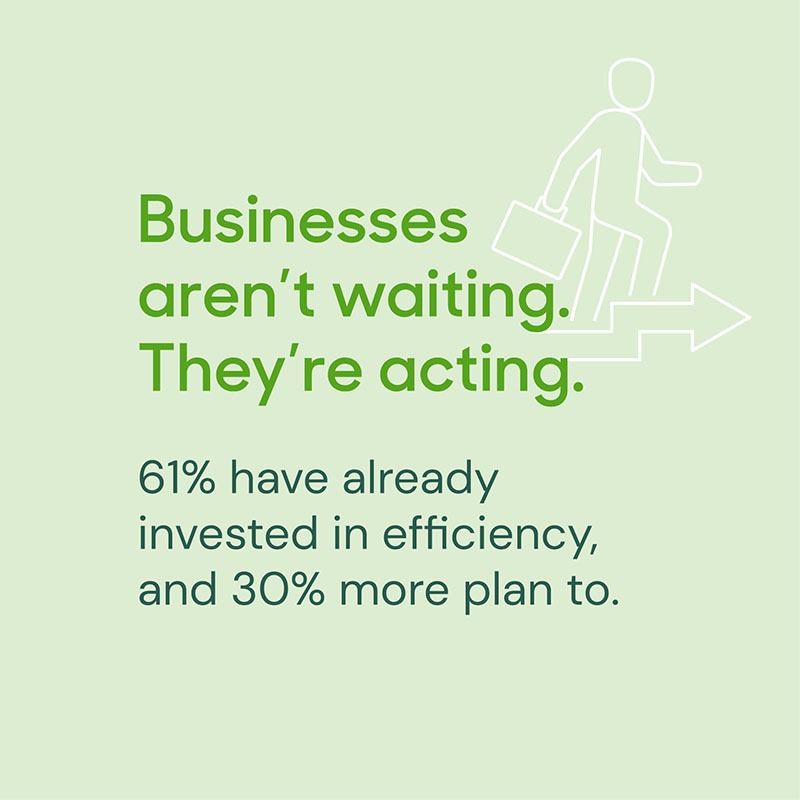
Source: energy.gov
Step 5: Make energy efficiency your competitive advantage.
Sustainability might sound like a buzzword — but in practice, it’s often the byproduct of smart, forward-thinking business decisions. And energy efficiency? It’s not just about cutting costs. It’s about building resilience, boosting productivity, and unlocking long-term value.
When you partner with your LPC to optimize systems or reduce reliance on fossil fuels, you’re not just reducing overhead, you’re:
- Strengthening your operational reliability.
- Improving safety and performance metrics.
- Reinforcing your long-term competitiveness.
Whether you run a manufacturing plant or a university campus, every efficiency upgrade is an investment in your facility’s ability to scale, adapt and thrive.
According to the EEM 2024 Energy Efficiency Investment Survey, 24% of annual operating costs for businesses go to energy.
Source: EnergyRight.com; energyefficiencymovement.com
Final thought: Loop them in early. Lean on them often.
Before you call your engineer, contractor or architect, call your local power company.
They’re already invested in your success. And when you treat them like a strategic partner, not just a service provider, the benefits ripple across your operations — from budget to resilience to bottom line.
Learn how TVA EnergyRight and your LPC can support your next project. Explore current incentives and energy solutions for your facility.
Calling all junior detectives! Use your sleuthing skills to spot sneaky leaks.

Is it a GHOST or a drafty window? Did a BLACK CAT just cross your path, or is there a breeze sneaking in under a door? Is your bedroom HAUNTED, because it’s always chilly — even when the heat’s on? If any of this sounds familiar, there may be energy mysteries in your home — and YOU can help solve them.

Here’s what you’ll need in your energy sleuth’s detective kit:
- Post-it notes (Write: “BOO! An energy ghost lives here!” on at least 12 of them)
- Craft feathers (the feathery the better!)
- Flashlight
- Thermometer (optional, for comparing room temps)
Ready for your first mission? Grab your energy sleuth’s detective kit and your grown-up because we’re going on a home energy ghost hunt.
Mystery #1: The ghost in the window.
Windows let you keep a friendly eye on the world outside, but sometimes they let in more than you’re bargaining for.
DETECTION: On a windy day — the windier the better! — grab the lightest feather from your kit. Very slowly move the feather around the edges of every window in your house. It’ll help you detect unwanted airflow around window frames, doors, baseboards, electrical outlets, crawlspaces, registers, and attic doors.
When your feather is “tickled” you’ve found a draft ghost! Sound the alarm (we recommend a ghoulish howl) and mark it with a BOO note.
Fresh out of feathers? Run your hand under cold water and you’ll be able to feel the ghostly drafts for yourself!
SOLUTION: For a low-cost fix, your grown-up partner can use clear weatherstripping or a window insulation kit to seal the gaps and keep warm air inside. For more hot tips on air sealing and insulation, be sure to check out this article!
Mystery #2: The case of the chilly door.
DETECTION: Make a list of all the doors in your home — front door, back door, sliding door, side door. Do any of them feel colder near the bottom? Can you see light coming in around the edges? Take a piece of paper and close it in the door. Then, try pulling it out. If it slides out easily, air is probably slipping through there, too!
SOLUTION: Add a door sweep or a rolled-up towel to block the draft. Feeling crafty? You can make and decorate your own “draft snake.”
Mystery #3: The clue of the cold floor.
DETECTION: On a chilly day, take your socks off — if you dare! — and walk around your home. Pay extra close attention to areas where your toes feel chilly. If you feel a cold spot, mark it with a BOO note.
SOLUTION: Ask your grown-up if you can help them pick out a few area rugs. You can even grab your flashlight and head down to your basement or crawlspace to look for leaks. Insulation and air sealing can help stop chilly floors.
Mystery #4: The secret of the whistling outlets.
Did you know cold air can sneak in through electrical outlets? Especially on outside-facing walls!
DETECTION: On a windy day, place the palm of your hand gently over light switches or outlets near exterior walls. Feel a tickle of air? That’s a hidden leak! Mark it with a BOO note.
SOLUTION: Encourage your grown-ups to take you on a field trip to your local hardware store to buy outlet gaskets. These inexpensive insulating foam pads go behind outlet covers — they’re easy to install and super helpful.
7 energy efficiency tips for renters.

Here are 7 ways to stay warm and save money on utility bills (while keeping your landlord happy).
Energy efficiency for renters — and staying warm and comfortable in colder months can be tricky. As a renter, you may not be able to control your home’s insulation, heating, or windows. However, you can save money on energy bills!
Here are 7 proven energy-saving tips that are good for renters and landlords. These budget-friendly ideas will help make your rental home feel cozy and energy efficient.
1. Start with a draft check
Before you make any changes, take a few minutes to stroll through your home and feel for drafts. Here are a few common problem areas you’ll want to investigate:
- Attics and crawlspaces (and their hatches).
- Window frames, panes and sashes.
- Door jambs, sills and windows.
- Plumbing and electrical penetrations.
- Dishwasher and refrigerator connections.
- Baseboards and where walls meet the ceiling.
- Electrical outlets and vent registers.
- Recessed lights, vents and fans.

You can either use the “damp hand” or “incense trick” to test for drafts. For the first option, run your hand under cold water and then hover it slowly around the problem areas mentioned above. Or, you can light a stick of your favorite incense and hold it near the problem areas mentioned above. If the smoke wavers or pulls, you’ll have found a leak.
2. “Seal and peel” or make your own “draft snake.”
Doors and windows are two of the biggest air leak offenders. Fortunately, they’re also pretty easy to tame.
If your landlord doesn’t want to install new windows or permanent weather stripping, you can use a removable “seal and peel” caulk. This caulk makes a temporary, airtight seal around leaky windows and doors. You can easily apply it and remove it without damaging paint or door surfaces.
And whether you’re feeling quick or crafty, you can create your own draft stopper — or “draft snake” for window sills, baseboards and doors. A rolled-up towel works great if you’re in the quick camp. If you’re the crafty type, spend a few moments searching for inspiration.

3. Seal your panes with shrink window film.
Single-pane windows are common in older rental homes and apartments. They can let a lot of warm air escape and cold air come in.
That’s where seal and shrink window film comes in. Most kits include double-sided, removable tape. To complete the job, you only need scissors and a hair dryer. These kits use clear plastic film that you tape around the window frame, cut to size and shrink tight with a hair dryer.
The film improves energy efficiency by reducing drafts. Plus the kits are easy on paint and even easier to remove in spring when you feel like flinging your windows open.
If you’re not up for installing film, thermal curtains or layered drapes can also help reduce heat loss — especially at night. Just be sure to open them during the day to let sunlight warm your space naturally.
4. Plug up outlet and switch leaks
You might be surprised, but cold air can come in through gaps around electrical outlets and light switches. This is especially true for outlets on outside walls.
You can block this airflow with foam outlet insulation gaskets or socket sealers. They’re super easy to install and cost just a few dollars per pack. Simply unscrew the outlet cover, place the gasket behind it, and screw the cover back on.
Looking for FREE outlet insulators? They’re included in your free energy-saving kit when you complete a free DIY Home Energy Assessment.

5. Put a blanket on … your floor.
If your home has hardwood flooring, a quick way to insulate (and keep your tootsies warm) is by placing area rugs in high-traffic or frequently used areas like your living room or bedroom. Think of them as a cozy blanket for your floors.
Not only do area rugs help your feet stay warm, but they can also help reduce heat loss through the floor — especially if your rental is above an unheated crawlspace or basement.
6. Take it down a degree or two.
If your home has a smart or programmable thermostat, be sure to take advantage of it. If they don’t, talk to them about installing a smart thermostat, which can help reduce energy costs even more. Some local power companies may even offer incentives on purchasing a new smart thermostat.
You can layer up and set your thermostat to 68° F. You can even set it lower when you are away or cozy under quilts in the evening. If that feels too cool, try to set your thermostat just a degree or two cooler than you might consider your ideal temperature.

If your space has room-specific heaters, close doors and heat only the rooms you use most often.
7. Take a FREE DIY home energy assessment.
Discover all the ways your rented home is using (or losing) energy with our free DIY Home Energy Assessment. Plus, you’ll receive an energy-saving kit and a $10 home improvement store gift card in the mail within four to six weeks.
Looking for more great ways to save on energy costs? Be sure to check out this article for more no-cost tips.
Air sealing and insulation tips to get your house knitted up for sweater weather.
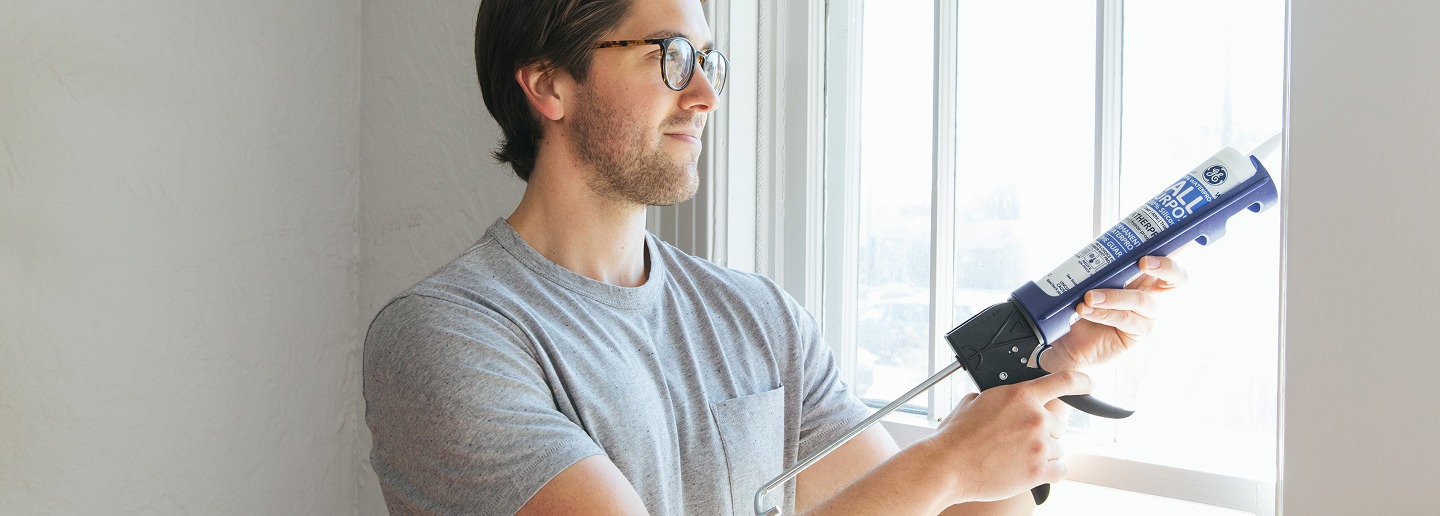
As the golden days of summer give way to crisp autumn mornings and icy winter evenings, now is the perfect time to prepare your home for cool weather days. One of the most effective, affordable — and often overlooked — ways to stay cozy and reduce your energy bills is DIY weatherization, insulation and air sealing.
If you’d like to learn more about DIY air sealing and insulation, read on! If you’ve done all the DIY you can do, and you’re ready for the pros to roll out the insulation, you’re in the right place. You can learn more about our Quality Contractor Network right here. Or, you can use our “Find a Contractor” search tool to take the guesswork out of finding a vetted, licensed and insured contractor for air sealing and attic and wall insulation rebate projects.
What Is Air Sealing?
If you’ve ever felt a chilly draft sneak under your door or watched your heating bills climb as the temperatures plummet, your home might be telling you it’s time to seal the gaps. The good news? Not only are air sealing and insulation rebates available from TVA EnergyRight® and your local power company but there’s plenty of time to take action now.
Air sealing is the process of closing up the small cracks, gaps, and holes in your home’s building envelope — the physical barrier between the indoors and outdoors. Even if you made the air sealing rounds last fall, we recommend making this an annual event. Homes — especially older ones — may settle and shift as seasons change.
What are common “problem areas” for air leaks?
As you consider air sealing your home, pay close attention to:
- Attics and crawlspaces (and their hatches).
- Window frames, panes and sashes.
- Door jambs, sills and windows.
- Plumbing and electrical penetrations.
- Dishwasher and refrigerator connections.
- Baseboards and where walls meet the ceiling.
- Electrical outlets and vent registers.
- Recessed lights, vents and fans.
Individually, these air leaks may seem minor but together, they can add up. And in the winter, they allow your precious warm air to escape while inviting cold air to seep in. Effective insulation and air sealing can help stop energy loss in its tracks.

What’s the best way to detect air leaks?
Professional home energy auditors use a device known as a blower door to determine the amount of air entering or escaping your home. A blower door is essentially a powerful fan that pulls air out of your home, lowering the air pressure inside. This allows higher pressure outside air to flow inside. The analyst will then use infrared cameras or nontoxic smoke to visualize the air leaks in your home.
If you’d rather take a low-cost DIY approach, you can conduct a low-tech building pressurization test yourself. It won’t be as precise and a blower door test, but it’ll put you on the right path.
- Check the forecast and time your test for a windy day — this makes it easier to feel the drafts.
- Turn off combustion appliances such as gas ranges, ovens, furnaces and water heaters.
- Close all your windows, exterior doors, vents, and flues.
- Turn on exhaust fans — like bathroom exhaust fans and range hoods — or use a tight-fitting window exhaust fan to suck air out of your home.
- Light an incense stick and pass it around the edges of common “problem areas.” (See above for a full list.) Not a fan of incense? Dampen your hand and slowly move it around these areas — drafts will feel cool to your hand.
Why does air sealing matter?
Lower energy bills
When your home leaks air, your heating system has to work harder to maintain a consistent temperature. That means higher energy consumption — and higher utility bills. According to the U.S. Department of Energy, air sealing and insulation can reduce heating and cooling costs by an average of 15%, and in some cases even more.
In the Tennessee Valley, where temperatures can swing dramatically between seasons, a well-sealed home helps your HVAC system operate more efficiently and last longer.
Improved comfort
A drafty home isn’t just inefficient — it’s uncomfortable. Air leaks can lead to cold spots in certain rooms, inconsistent temperatures between floors, and the frustration that comes with being both uncomfortable and tired of spending more on heating.
When you seal air leaks and add the right amount of insulation, your home maintains a more consistent temperature year-round.
Better indoor air quality
Air sealing also helps protect your indoor air. Gaps in your building envelope don’t just let conditioned air escape — they can let in dust, pollen, mold spores — and even unwanted pests and houseguests (of the critter variety). In some cases, leaks from crawlspaces or attics can allow moisture to accumulate, resulting in a musty odor or mold growth.
Air sealing and insulation can be a big win for allergy sufferers and families with young children or older adults.
How can I fix air leaks?
You don’t have to do everything at once. Focus on key areas that can make the biggest difference:

Seal doors and windows.
- Use weatherstripping around doors and movable window sashes.
- Apply caulk to seal cracks around stationary window frames and exterior trim.
- Install door sweeps to block drafts at the bottom of exterior doors.
Address the attic and crawlspace.
- Look for gaps around plumbing vents, electrical wiring, and chimneys in your attic.
- Use expanding foam or caulk to seal small holes, and install covers or gaskets where needed.
- In crawlspaces, sealing gaps between the foundation and framing can stop cold air from entering your floors.
Add or upgrade insulation.
If you want to level up, consider adding or upgrading your insulation. In the South, many homes are under-insulated — especially in older houses. If the floor joists are exposed in your attic, for example, that’s a strong indication that you need additional insulation. Fortunately, rebates are available. Here are key areas to consider:
- Attic insulation: Consider blown-in cellulose or fiberglass batt insulation to reach the recommended R-values for your region.
- Crawlspace insulation: Insulating the floor above the crawlspace can help maintain warmth on the first floor.
- Wall insulation: Harder to retrofit, but sometimes possible with dense-pack cellulose or foam injection.
You don’t always need a full insulation overhaul. Even topping off attic insulation or insulating around rim joists can make a big difference.
Not sure where to start? We’re here to help.
With the right support and incentives, making your home more efficient doesn’t have to be complicated. Start by exploring rebates available for insulation, air sealing, heat pumps, mini splits, and other energy upgrades.
Need a contractor you can trust? Use TVA EnergyRight’s Quality Contractor Network to find licensed, insured professionals who are vetted for quality, safety, and customer service.
25 ways how to save on your energy bill.
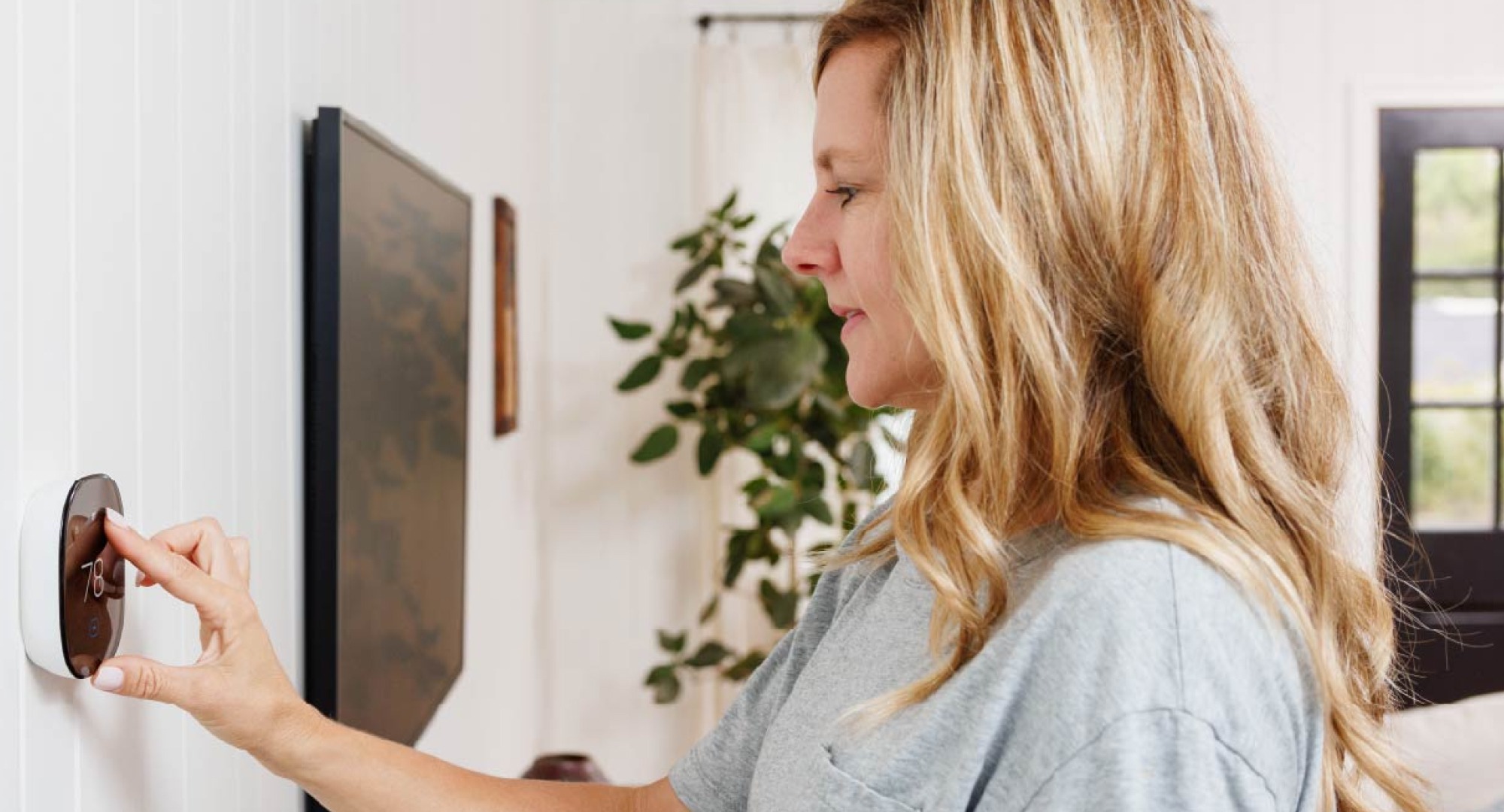
Wondering how to save on your energy bill? Give these energy-saving tips and easy updates a whirl.
Whether you rent or own your home, TVA EnergyRight® and your local power company are here to help you get started on your energy-saving journey. We’ve rounded up 25 ways to boost your home’s energy efficiency. Saving energy — and money — can be as easy as the flip of a switch.
Read on to find free DIY home improvements, and learn more about valuable rebates on home energy upgrades!
25 ways you can save on your energy bill.
1. Take our free DIY Home Energy Assessment.
Answer a few questions about your home, appliances, insulation, and heating and cooling systems to find out how your home uses and loses energy.
At the end of your DIY home energy assessment, you’ll gain access to an interactive online dashboard with energy improvement recommendations specific to your home. Plus, you’ll receive a free energy-saving kit and a $10 home improvement store gift card in the mail.
2. Find a home energy rebate that’s right for you.
From up to $3,000 rebates on HVAC systems to hundreds of dollars off air sealing and insulation, home energy rebates from TVA EnergyRight and your local power company increase the affordability of upgrades that lower utility bills and boost your indoor comfort. Explore rebates.
3. Set calendar reminders for monthly tasks and recurring energy-saving chores.
Let technology do the worrying for you! For recurring events, like changing your air filter at least once every three months or switching the direction of your ceiling fans seasonally (counterclockwise in the summer and clockwise in the winter), simply add them to your calendar and enjoy the satisfaction of checking them off as they pop up!
4. Save with smart power strips.
Slay vampire energy — that’s the electricity your electronics use when they’re plugged in, but not in use — and save as much as $100 per year. Reduce your standby power load and save 5-10% with smart power strips, ENERGY STAR appliances and by unplugging infrequently used electronics (Energy.gov). It’s surprising, but small appliances like curling irons, electric razors and printers use energy even when you’re not using them. If you plug it in, and you use it only occasionally (or briefly), power it all the way down when you’re done and unplug it from the outlet.
5. Adjust your thermostat by a few degrees.
Heating and cooling your home uses a lot of energy. Did you know that you can save up to 10% on your total air conditioning costs with a smart thermostat (Energy.gov)? For optimal savings, we recommend keeping your thermostat set to 78° F in the summer and 68° F in the winter.
6. Join our Smart Thermostat Rewards program.
When you join our Smart Thermostat Rewards program, you can help keep energy costs low and get rewarded with sign-up and annual rebates. Note: not all local power companies are participating in the program.
7. Schedule an HVAC system tune-up.
Routine HVAC maintenance can improve your system’s efficiency and help it last longer. Get a tune-up on your electric heating or cooling system and redeem your $50 rebate. Explore all rebates.
8. Have your duct system professionally inspected and maintained.
Did you know that leaky, uninsulated ducts can reduce the efficiency of your heating and cooling systems by up to 20%? Keep clean air flowing and keep your heating and cooling systems working at peak efficiency. (ENERGYSTAR.gov)

9. Uncover blocked air vents.
If there’s anything blocking your air vents or intakes — like a couch, bed, rug or pile of backpacks — it’s going to make your HVAC system work harder to keep a controlled temperature. You want unobstructed vents for maximum airflow and maximum energy savings.
10. Weatherstrip your doors and windows.
A little gap here, a little gap there … add up. The experts at This Old House have found that a gap as small as ⅛ inch around the entryway of a door is like drilling a 5-inch hole through the outside wall! Seal everything up with caulk and weatherstripping.
11. Fuzzy bunnies are cute. Dust bunnies aren’t.
Dust, lint and pet hair are attracted to ductwork, bathroom exhaust fans, and the back of your refrigerator — we love furry friends, but we’re not fans of dust bunnies. All that dust makes your appliances work harder, increasing your energy bill and adding unnecessary extra wear and tear.
12. Install high-efficiency LED lights.
Installing 10 high-efficiency 60W equivalent LED bulbs can save you more than $50 per year! And of course, saving energy is as easy as a flip of a switch — so be sure to turn off lights as you leave a room.
13. Use the dishwasher instead of washing dishes by hand.
An ENERGY STAR® dishwasher uses less than four gallons of water per cycle and can save about 3,850 gallons of water in its lifetime. On the other hand, washing dishes by hand uses four gallons every two minutes! That means running a partial load is probably going to be more efficient than handwashing a sink full of dishes. (We think that’s worth celebrating!)
14. Skip the pre-rinse, really!
The energy efficiency of dishwashers has come a long way (see above), and so has the cleaning power of dishwashing detergents. In fact, enzyme-based dish detergents work better when they have a little something to cling to. Food scraps still need to go into the garbage or compost, but skip the pre-rinse and you’ll save water and electricity.
15. Set it and forget it.
Setting your water heater to 120° F can save you up to 22% annually. It’s also hot enough for a good shower and not so hot that it scalds!
16. Pull the refrigerator slightly away from the wall.
Your refrigerator needs room in the back so air can circulate and the heat it generates has space to dissipate. Make sure there are about two inches between the refrigerator and the back wall.
17. Keep your freezer full and avoid overfilling your refrigerator.
An overfull refrigerator or freezer traps cold air, and a full, but not-too-full, refrigerator and freezer mean air can flow and your items will stay cold.
18. Clean your oven and range.
Much like dirty or dusty refrigerator coils, a dirty stove has to work harder to heat itself, and that’s going to drive up your energy costs. (It can be hazardous, too!) Fill up a spray bottle with a mixture of water, white vinegar and dish soap and start scrubbing.
19. Match pot and pan sizes to burner sizes.
Large burners use more energy. A too-small pot or pan on a large burner means you’re heating space with nothing on it and burning up easy savings.
20. Here comes the sun! Be solar savvy.
Close your curtains and blinds during hot summer days to reduce solar gain. In the winter, let the sun shine in — but remember to close your curtains and shades in the evenings.
21. Take time off from tech.
This one’s as much a challenge as it is a tip: Pick one night a week to go screen-free. Substitute TV, tablets and video games with activities that use less electricity but burn more energy (and are arguably more fun) like strumming a guitar, playing a classic board game, solving an old-school puzzle or reading a good book.
22. Use the spin cycle and air-dry (some of) your laundry.
Give your clothes an extra spin to minimize drying time. You can even “damp dry” items and hang them to dry on an attractive — and foldable — drying rack.
23. Clean the dryer vent.
You may be sensing a trend here, but as with your HVAC air filters and refrigerator coils, a full lint trap makes your dryer work harder, plus it’s also a fire hazard. Empty the lint trap after every dryer use. Twice a year, clean the full dryer vent, the part that extends from the back of your dryer to the outside of your home. This is especially important if your dryer stays in heavy rotation and/or you have furry pets.
24. Rent or buy an e-bike.
E-bikes give you all the fun of a traditional bicycle, but they’re easier on the joints — and get you where you’re going a little quicker. They’re great for light grocery runs and cargo bikes are a hit with the kids! Park the car, save on fuel and head out for an adventure.
25. Try out mass transit.
If you live in an urban area, give public transportation a whirl. Online apps and maps make it easier than ever to see schedules and pay. Next time you’re headed to a concert, sporting event or the mall, hop on your area’s local public transportation and save a bundle.
How to beat the heat this summer: Smart energy-saving tips for your business.
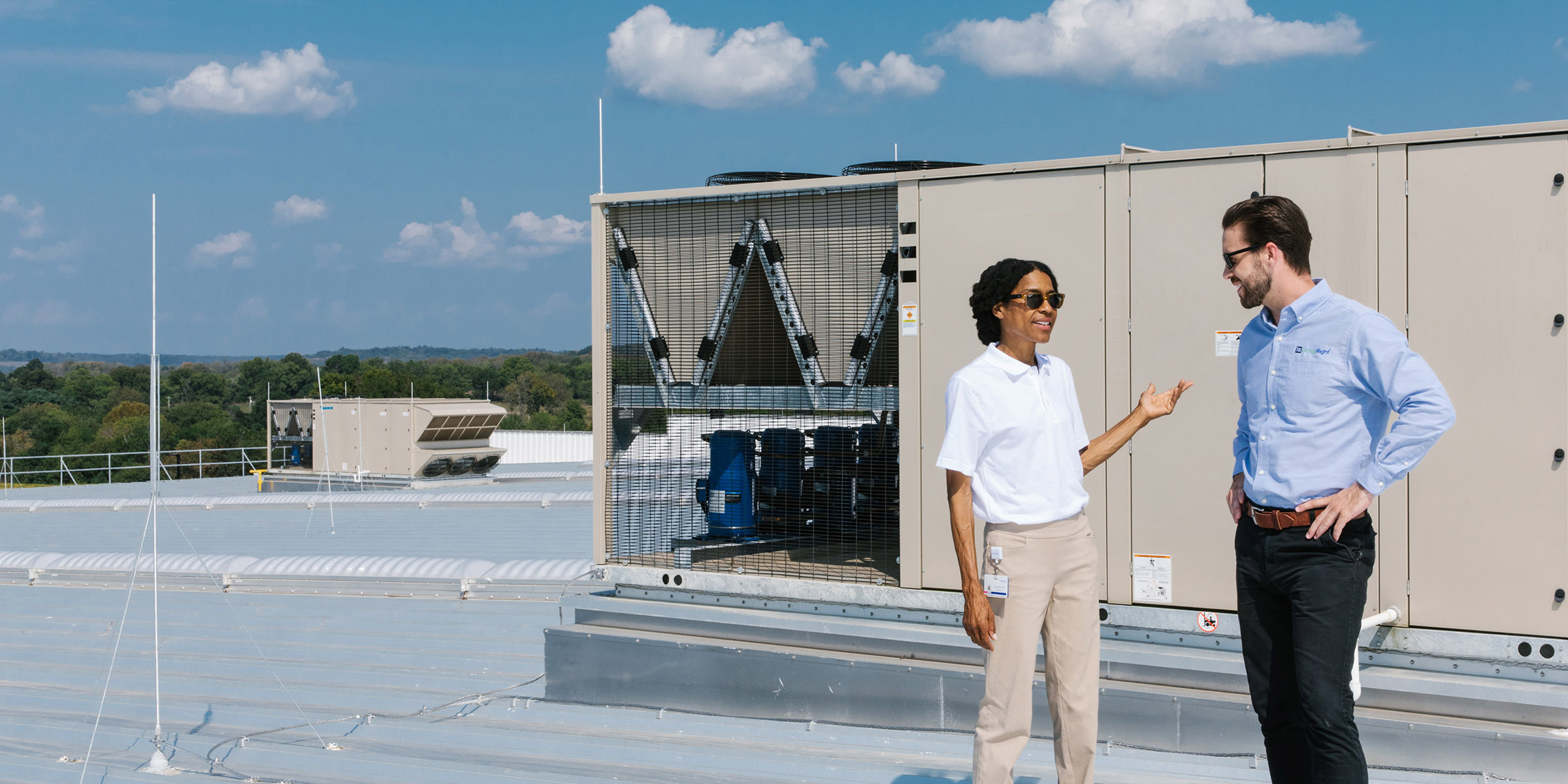
When the temperatures rise, so can your energy bills — but they don’t have to. With a few smart upgrades and efficiency moves, your business can stay cool without overheating your budget. Here are some energy-saving tips to reduce business energy use.

1. Tune up your HVAC system.
Your HVAC system works harder in the summer, which means small issues can turn into big energy drains. Schedule a seasonal inspection to check refrigerant levels, clean coils and replace filters. It’s one of the easiest ways to boost performance and cut unnecessary costs. Or check out our HVAC incentives, which can help you replace aging units while improving comfort and efficiency year-round.
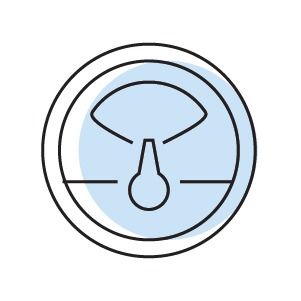
2. Upgrade to smart thermostats.
Smart or programmable thermostats help you avoid cooling empty spaces. Set temperature schedules based on work hours and occupancy zones to ensure you’re only using energy when and where you need it.
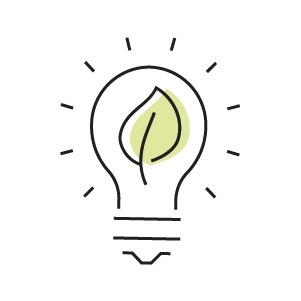
3. Switch to energy efficient lighting.
Still using outdated bulbs? LED lighting uses up to 75% less energy and generates less heat than traditional lighting. That means your cooling system doesn’t have to work as hard either — a win-win in the summer months.
Check out our LED lighting incentives to learn more.

4. Take advantage of TVA EnergyRight® incentives.
From high-efficiency HVAC systems to lighting retrofits, TVA EnergyRight offers incentives to help businesses make smart upgrades.

5. Seal air leaks and improve insulation.
Warm air creeping in and cool air leaking out can quietly drive up your summer energy bills. Inspect doors, windows and ductwork for leaks and add weather stripping or insulation where needed. Sealing up your space keeps cool air in, hot air out and your HVAC system from working overtime.
Source: sba.gov
Stay cool and stay ahead.
Getting your business ready for hot weather doesn’t have to be complicated or costly. With these energy-saving tips for businesses, you can reduce energy costs and keep your operations running efficiently all season long.
